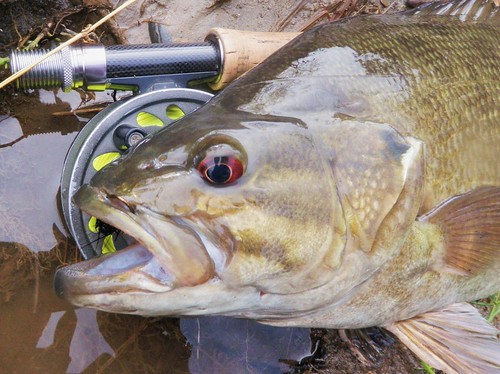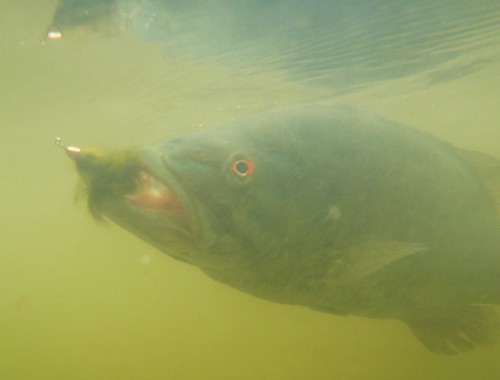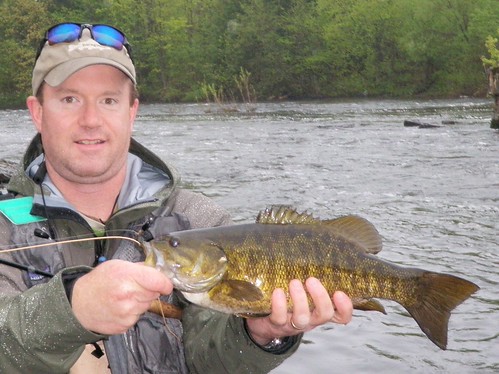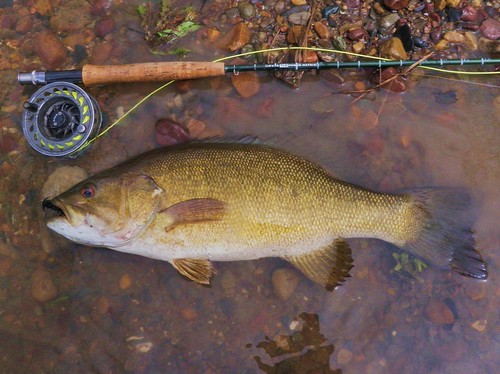 |
When April begins, I start thinking about smallmouth bass. They will soon start making migratory spawning runs out of lakes, and some huge fish will be caught. It can be some of the most fun fishing of the entire year.
When smallmouths make their spawning runs not all of the fish in the population will enter rivers and streams to spawn. Instead, it is a portion of the population, and the numbers that do migrate can change from year to year depending on conditions. Lower water years will often see fewer fish return than higher water years. Interestingly, a bass that spawns in a river one year could spawn out in open water the following year. There seems to be no real reason why they decide to make the run, and while I would love to know what makes them run, ultimately, that they are in is all that matters.
Gearing up for spring smallmouths is pretty easy, and most trout gear will work fine. A 5- to 7-weight outfit is perfect for chucking the flies you’ll need. Because bass are generally in water less than 5 feet deep, and often much less than that, a floating line is fine. Although standard leader will get the job done, I recommend fluorocarbon tippet. Fluoro will help out in several ways, but of the greatest importance is the abrasion resistance that it provides. It will help fishing some of the tight spots bass are in, and it will also help guard against sandpaper-like teeth. When you are catching smallmouths, definitely check your leader frequently. Those small teeth will slowly grind down your tippet, eventually causing it to fail. If your tippet feels rough, then cut your fly and some of the tippet, and then re-tie your fly on. I find this is necessary every half dozen fish or so.
 |
A well stocked streamer box will be all that you need to chase these bass. Woolly Buggers and Zonkers in a wide variety of colors are some of the most productive flies, with black, olive, and chartreuse as some of my favorites. Bob Clouser designed his Deep Minnow specifically for smallies, and it is worth having a variety of colors of those, as well, but especially chartreuse-and-white, pink-and-white, and olive-and-white. Other flies that work well include crawfish patterns, weighted muddlers, and other baitfish patterns. Quite honestly, if any fly is moving through the water, a bass will probably hit it this time of year! They are pretty aggressive, most notably during the first few weeks that they show up.
When bass initially enter a river, they will be found primarily in deeper holes. In the spots I fish year after year, there are always a couple of holes where I expect to get my first bass or two of the season, and invariably that is just where I find them. They are in the deepest pools, near the back end, or the slack water on the inside of a corner pool. During periods of cooler water, earlier in the run, this is where you should concentrate your efforts. As it warms up, the bass will spread out more thoroughly through the river, and you will find them in faster water like tailouts, the heads of pools, deeper runs, and even riffles. As they prepare to spawn, the bass will also be found in slack water near faster water. Other areas to concentrate on are spots where there is a lot of structure. Smallmouths love woody debris, so make sure you put casts near deadfalls. Big rocks and other current breaks are also places to focus on. Don’t be surprised if you lose some flies doing this, but if you don’t try, you won’t catch those fish that are in the tight spots.
Some of the largest fish I catch every year are in the very beginning of the run, and certainly some of the most heavy bodied fish can be found in the first couple of weeks. Generally, the females show up first, and they are gravid, filled with eggs. The water tends to be cooler in the first few weeks, so successful techniques are a bit different than you may be accustomed to. There are two different things I try this time of year to entice the bass to take, and both work quite well.
 |
First is what I call the “strip, pause.” I cast the fly out (usually a Clouser), let it sink, strip in about a foot of line, pause for a couple of seconds, and then repeat until I am ready to cast again. This is especially effective in deeper water. Bass often grab the fly when it is on the drop, so make sure you have a tight line. Another useful technique is to dead-drift a bugger through a likely holding area and occasionally twitching the fly with my rod tip or stripping in a bit of line to move it. If the line stops at all, raise your rod. You will often find a feisty bass on the end of it.
As the water warms up into the 50s and 60s, the action will get hotter. You can strip flies through pools and runs to get explosive takes. It pays to experiment with what retrieves work best. Sometimes it is a fast erratic stripping motion that does the trick, and other times the “strip, pause” is more to their liking. Either will catch fish on any given day, but sometimes one technique will out fish another.
As the spawn continues you will find males sitting guard on beds. These fish will respond to a fly stripped through the area they are monitoring. They will be quite aggressive when they have just started guarding their brood and may become less so as time goes by. They can also be somewhat spooky. Use common sense when it comes to targeting these fish. If you do, land the fish as quickly as possible and release it close to the nest. However, I will caution you about doing this frequently. These fish are very vulnerable to exploitation. They are visible and often in shallow water. Removing them from the eggs or fry they are guarding can lead to high mortality rates. While this is not likely to have significant impacts on the overall population of smallmouth in the area, it is a practice that needs consideration.
 |
There are times when the water levels get low and there is excellent clarity. This is when the bass can get down-right “snotty,” as my friend Tom Rosenbauer calls it. He really seems to relish when they get like this because they can be much more challenging. There are a few tricks to help out with a situation like this. First is to drop down in tippet size, even if you are using fluoro. A less visible leader will help get takes. Also reduce the size and weight of your fly. You may need a size 8 fly to get them to take. Concentrate on deeper water and make longer casts. A great fly in this situation is a simple black bunny leech with little or no weight and no flash. Dead-drifting this fly can be a lethal tactic.
When the water warms up significantly, possibly in the 60’s or 70’s, you can have a great time using smaller Dahlberg Divers or poppers. Smallies seem to relish topwater flies, and any lingering fish can be tempted to come up to grab a fly from the surface. Size 2-8 flies will cover you well.
Spring smallmouth bass can offer some of the best fishing of the year. There are lots of big fish around, and they put up an awesome fight on light tackle. If you do it right you could end up with that most pleasant of all angling afflictions: the Bass Thumb!
 |
Drew Price lives in Northern Vermont and is the owner and head guide for Master Class Angling. He fishes Lake Champlain and surrounding waters targeting carp, pike, bowfin, gar, bass and other species (even the occasional trout).
Boom...Morgan
No comments:
Post a Comment